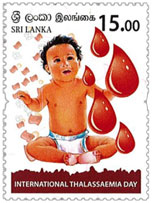

Home/Active Page

The Philatelic Bureau of the Department of Post has Issued a new postage stamp in the denomination of Rs. 15.00 on 08 May 2019 to mark the International Thalassemia Day.
| Date of Issue | 08th of May 2019 |
| Denomination | Rs.15.00 |
| Catalogue No: | CSL 2326 |
| Stamp Designer | P.Isuru Chathuranga | Stamp Size: | 30mm x 41mm |
| Sheet Composition: | 20 stamps per sheet |

The Philatelic Bureau of the Department of Post has Issued a new postage stamp in the denomination of Rs. 15.00 on 08 May 2019 to mark the International Thalassemia Day.
The International Thalassaemia Day, celebrated annually on the 8th of May, is a commemoration day in honour of all patients with thalassaemia and their parents who have never lost hope for life, despite the burden of their disease, and to all scientists who, with tireless dedication and enduring efforts, are striving to ensure an improved quality of life to people with thalassaemia across the world.
Thalassaemia belongs to a family of genetic conditions affecting the human blood, known as Haemoglobin disorders or Haemoglobinopathies. Haemoglobin disorders are a group of conditions affecting haemoglobin, an important substance or protein of the human blood contained in the red blood cells, hence the name haemoglobin disorders or haemoglobinopathies.
Haemoglobin disorders, including thalassaemia are an international concern. It is estimated that 7% of the world population is a carrier of a severe haemoglobin disorder and 300,000 -500,000 children are born with a severe haemoglobin disorder each year. Research advances in the clinical care of thalassaemia have managed to transform thalassaemia from a fatal disease of childhood that it once was into a chronic, yet well-managed disease, increasing patients’ survival rate and improving their quality of life.
Thalassemia is a disease that is passed down through a mutation in the genes. When two persons who have Thalassemia traits but may not display any symptoms, it is possible that they produce children with Thalassemia.
Over 3500 children in Sri Lanka live with Thalassemia. Children with Thalassemia have to under blood transfusions from the age of 05 months to the end of their lives. Furthermore, they have to be constantly on medication which help them eliminate the excess iron which is deposited in the body due to constant blood transfusions. Such transfusional iron overload causes morbidity among patients resulting in complexities that lead to heart, renal and liver failure which could lead to death at an early age.
It is estimated that there are approximately 500,000 Thalassemia carriers in Sri Lanka but most are unaware that they are carriers.
All rights received. All right to identify the Department of Posts as the Author and designer of this Bulleting has been asserted in accordance with the Copyright, Design and Patents Act 1988.No part to this publication may be reproduced, stored in or introduced into a retrieval system, or transmitted in any form or by and means (electronic, mechanical, photocopying, recording or otherwise) without the prior permission from the publisher. Any person who does and unauthorized act in relation to this publication may be liable to criminal prosecution and civil claims for damages.